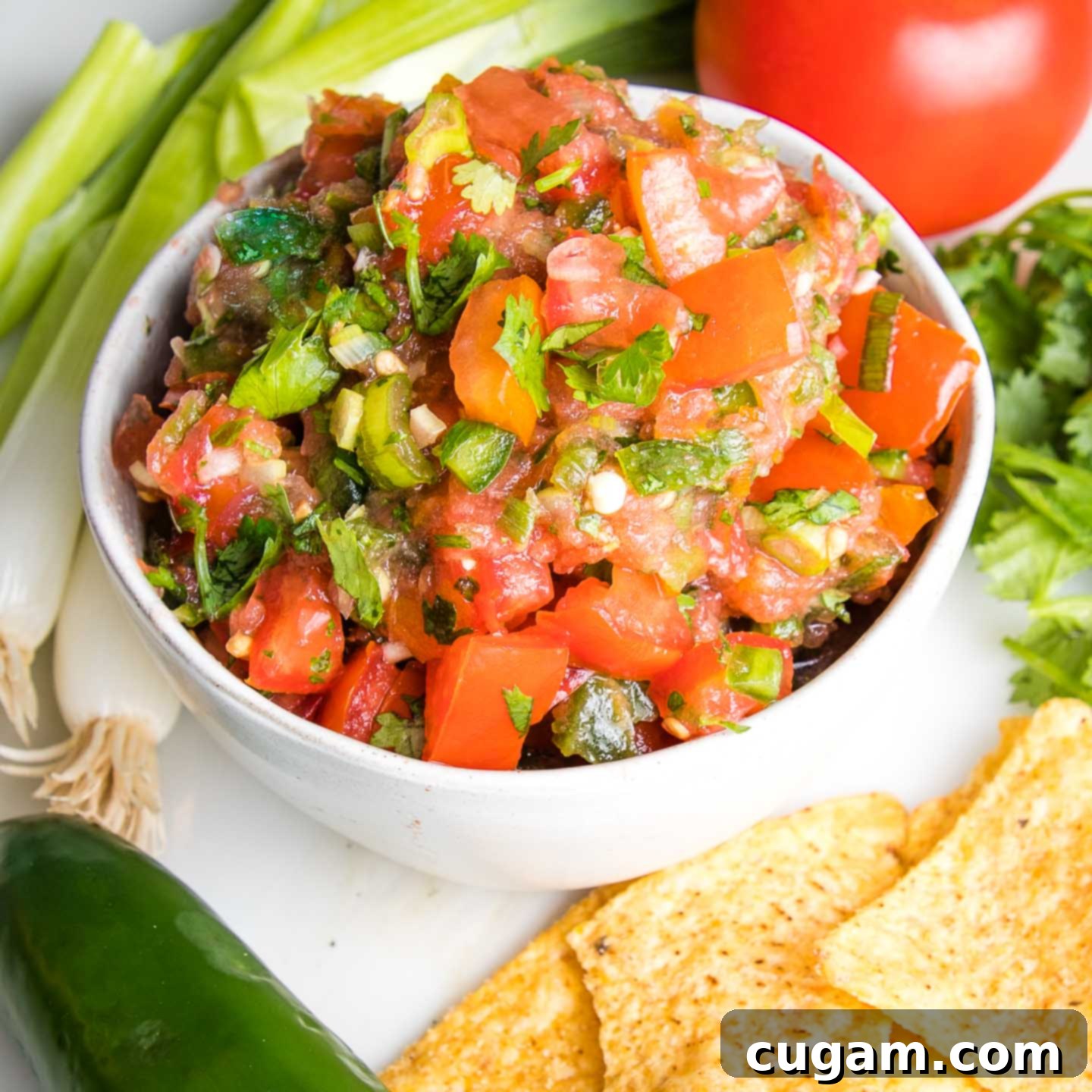The BEST Fresh Chunky Tomato Salsa Recipe: A Seasonal Staple
There’s nothing quite like the taste of ripe, in-season tomatoes. When they are at their peak, bursting with natural sweetness and vibrant acidity, you need only a handful of simple ingredients to create something truly magical: The BEST Fresh Chunky Tomato Salsa. This quick and incredibly easy salsa recipe isn’t just a dish; it’s a celebration of summer, a staple in our household all season long. Its bright, zesty, and utterly delicious flavor makes it the perfect appetizer for any gathering, and an indispensable condiment to spoon onto your tacos, burritos, black bean burgers, fajitas, or simply enjoy with a bag of crispy tortilla chips.
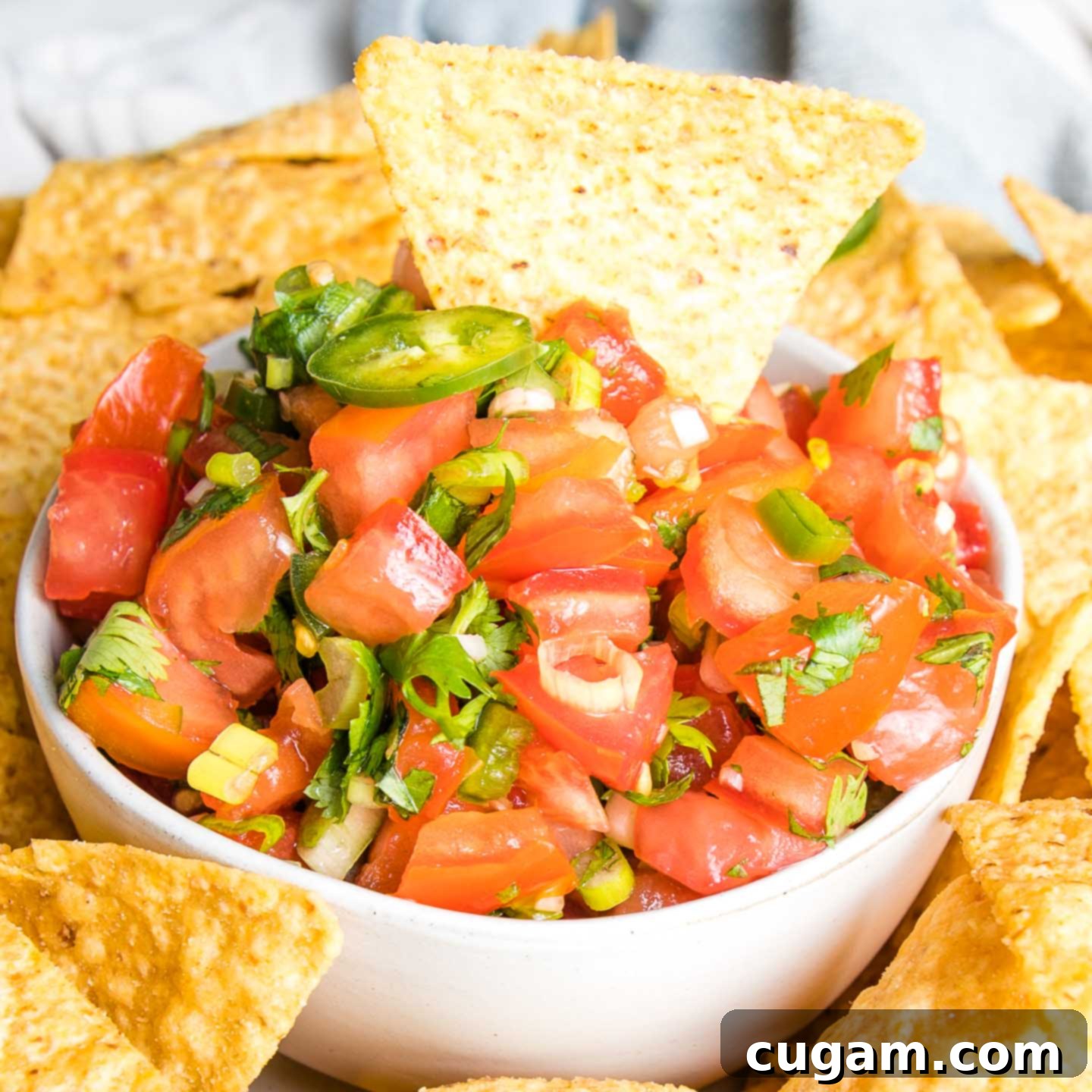
Crafting homemade salsa from tomatoes picked fresh from the garden or sourced from a local farmers’ market is an experience in itself. It takes just 10 minutes of active preparation, yet the resulting flavor is exponentially superior to any store-bought alternative. Each spoonful is an explosion of freshness, a testament to the quality of ripe, seasonal produce. Beyond salsa, when my garden is overflowing with tomatoes, I love transforming them into a refreshing tomato and onion salad or savory stuffed tomatoes. While many might recognize this fresh, uncooked salsa as “pico de gallo,” the name matters less than the quality of your ingredients. The key to success is unequivocally fresh tomatoes – never refrigerated – which retain their perfect texture and full flavor. So, grab your best produce and get ready to create a truly unforgettable fresh tomato salsa!
Ingredients and Substitutions for the Perfect Salsa
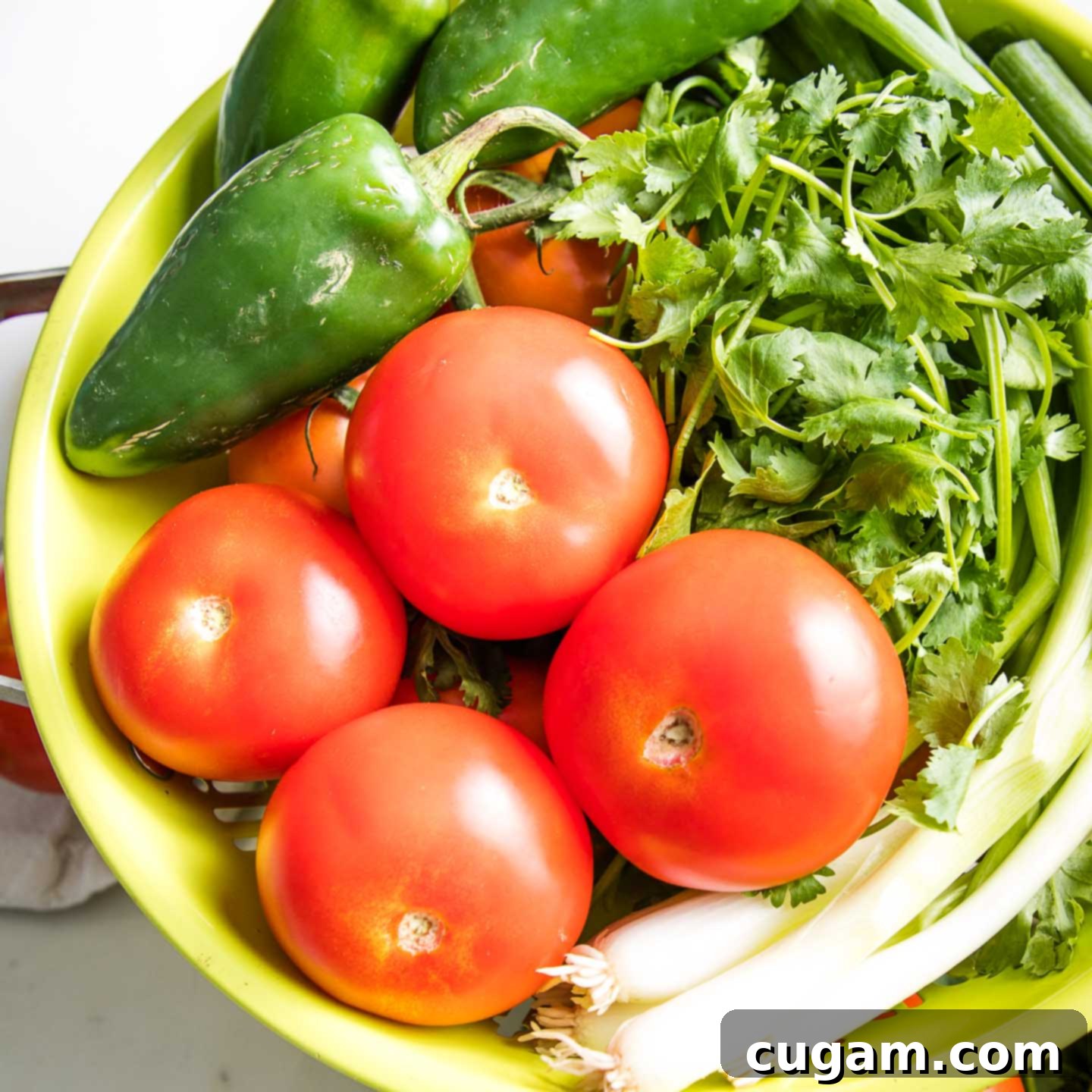
This chunky tomato salsa relies on just four core ingredients, each playing a crucial role in its flavor profile. Understanding each component and its potential substitutes can help you tailor the salsa to your exact preferences.
- Tomatoes: The Heart of the Salsa
Fresh, ripe tomatoes are non-negotiable for this recipe. They are not only the primary flavor component but also packed with essential nutrients like Vitamin C, Vitamin K, potassium, and folate. The natural sugars and acids in fresh tomatoes create a balanced and vibrant base. Choosing the right variety is key, and we’ll dive into that in detail below. Remember, the fresher the tomato, the less additional seasoning you’ll need. - Cilantro: The Aromatic Brightener
For many, cilantro is the quintessential herb for salsa, lending a distinct, fresh, and slightly citrusy aroma that elevates the entire dish. Its bright flavor perfectly complements the tomatoes and peppers. However, if you are among those who find cilantro tastes like soap (a genetic predisposition, we’re told!), please don’t despair! You can absolutely achieve a delicious salsa by substituting with fresh parsley or even fresh oregano. These alternatives will still provide that vital herbal freshness without the divisive flavor. - Green Onion (Scallions): The Mild Allium Kick
Green onions, also known as scallions, offer a delicate, mild onion flavor that doesn’t overpower the other ingredients. Both the white and green parts are used, adding a subtle sharpness and a beautiful visual pop. If green onions aren’t available or you prefer a stronger flavor, finely chopped red onion or shallots are excellent alternatives. Red onion will give a more pungent kick, while shallots provide a slightly sweeter, milder onion essence. - Jalapeño Peppers: For Flavor with Controllable Heat
Jalapeños are fantastic for adding a touch of warmth and their characteristic earthy, slightly grassy flavor without making the salsa overwhelmingly spicy. The majority of a jalapeño’s heat resides in its membranes and seeds. For a milder salsa that still boasts that authentic jalapeño flavor, simply remove these before chopping. If you’re a heat-seeker, feel free to leave some seeds in, or opt for spicier peppers like serrano for a noticeable kick, habanero for serious heat, or even a ghost pepper for the truly daring! - OPTIONAL Seasonings: Enhancing Natural Flavors
While the incredible freshness of your tomatoes might mean you need very little else, a few optional seasonings can round out the flavors beautifully. Consider adding a pinch of coarse salt to bring out the tomatoes’ natural sweetness, a dash of cumin for an earthy depth, a touch of chili powder for extra warmth, or a hint of onion powder or pressed garlic for a more pronounced savory note. A squeeze of fresh lime juice is also often added to brighten all the flavors. Always taste as you go; the fresher your main ingredients, the less additional seasoning you’ll typically need.
What Kind of Tomatoes Are Best for Homemade Salsa?
The choice of tomato is paramount when making fresh salsa. The ideal tomato will contribute to both the flavor and the texture of your chunky creation. Here’s a detailed guide to selecting the perfect tomatoes:
- Firmness and Slicing Quality: Always look for firm tomatoes. They should feel heavy for their size and have a taut skin. Varieties that are good for slicing typically work best, as they have a good balance of flesh and juice, allowing for clean cuts and desirable chunks.
- The Gold Standard: Beefsteak and Heirloom Tomatoes: I personally adore a juicy beefsteak tomato or any vibrant heirloom variety for my salsa. These tomatoes offer an incredible depth of flavor, often a perfect balance of sweet and tart, and have a wonderfully meaty texture that holds up well to chopping. They truly embody the “authentic taste” of summer.
- The Crucial Rule: Fresh, Never Refrigerated! This cannot be stressed enough. Tomatoes lose their flavor and develop a mealy, undesirable texture when refrigerated. Always store them at room temperature, ideally on your counter, until ready to use. This simple rule will make a world of difference in your salsa.
- Roma Tomatoes: The Less Watery Choice: Some people prefer Roma tomatoes (also known as plum tomatoes) for salsa because they have fewer seeds and less juice, resulting in a less watery salsa. While this can be a benefit for those who prefer a very thick salsa, I personally save my Romas for sauces and prefer the juicier varieties for a more vibrant, fresh eating experience.
- Cherry, Grape, and Pear Tomatoes: Sweet & Convenient: When these are what I have on hand, they absolutely work! However, cherry, grape, and pear tomatoes tend to be sweeter than larger varieties. While delicious, I generally prefer a more savory and acidic tomato for the robust flavor profile of my ideal salsa. They can be great for a sweeter, more fruit-forward salsa.
- A Spectrum of Color and Flavor: Don’t limit yourself to just red! Red, orange, and yellow tomatoes are all excellent choices. In fact, I love to use a combination! Typically, yellow tomatoes will be the sweetest, while red varieties often bring more tartness and acidity. Pairing a sweet yellow with a more tart red creates a wonderfully complex and DIVINE flavor profile.
- Beyond Tomatoes: Tomatillo Salsa: If you’re lucky enough to find fresh tomatillos, they make an absolutely awesome salsa verde! The recipe shares many similarities with this one, requiring just a few flavorful tweaks for a distinct and delicious green salsa.
Mastering Your Salsa Preparation: Choose Your Method
Making homemade salsa is wonderfully adaptable to your comfort level in the kitchen and the tools you have. There are primarily two distinct methods, plus a “hybrid” approach that offers the best of both worlds. Consider these serious questions: How much time do you have? And how comfortable are you with a knife? Your answers will guide you to the perfect preparation style.
Food Processor or Blender Salsa: The Speed Demon
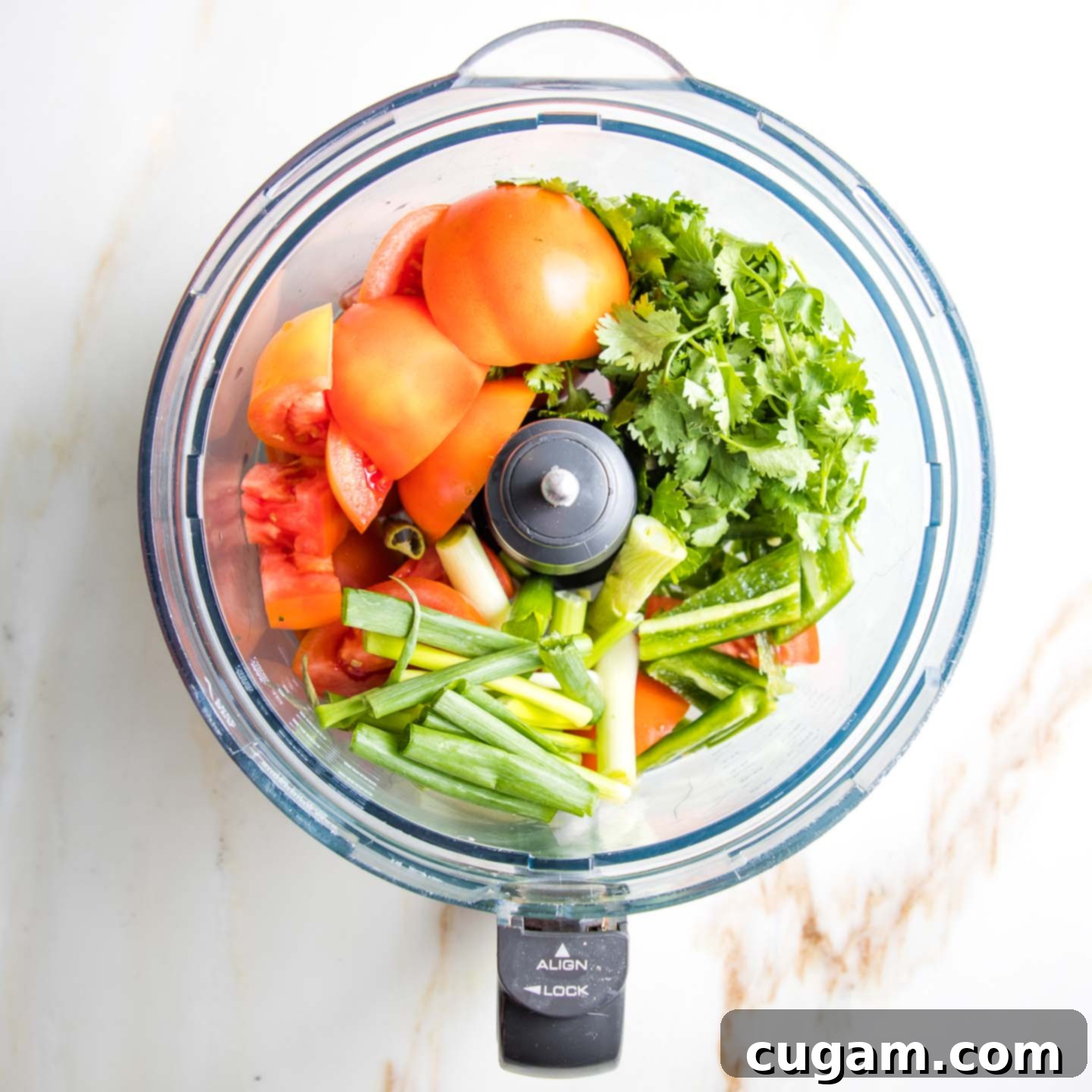
This is undeniably the quickest and easiest way to make fresh salsa, perfect for those moments when time is of the essence. You simply do a rough chop on your ingredients, dump everything into the bowl of a food processor or blender, and let the machine do the work. It’s ideal for a very fine, restaurant-style salsa or when you’re making a large batch.
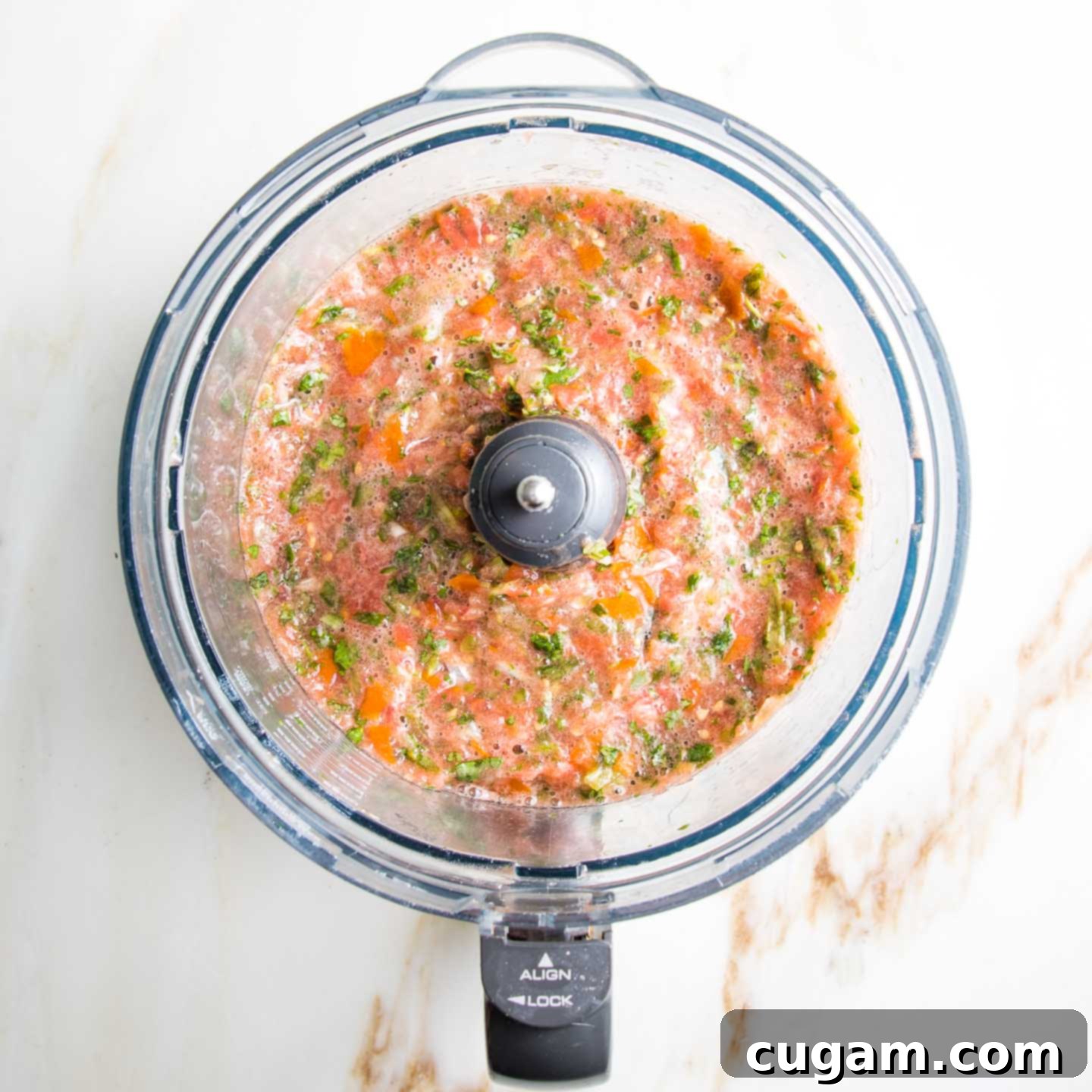
Wham, BAM… done! From whole ingredients to fresh salsa in less than a minute. The key here is to pulse, not continuously blend. Pulsing allows you to control the texture, achieving your desired level of chunkiness without turning your salsa into a watery purée. A few short pulses for chunky, a few more for a smoother consistency. Be careful not to over-process, as this can release too much liquid and diminish the vibrant, fresh texture.
Chop by Hand: The Artisanal Approach for Perfect Chunks
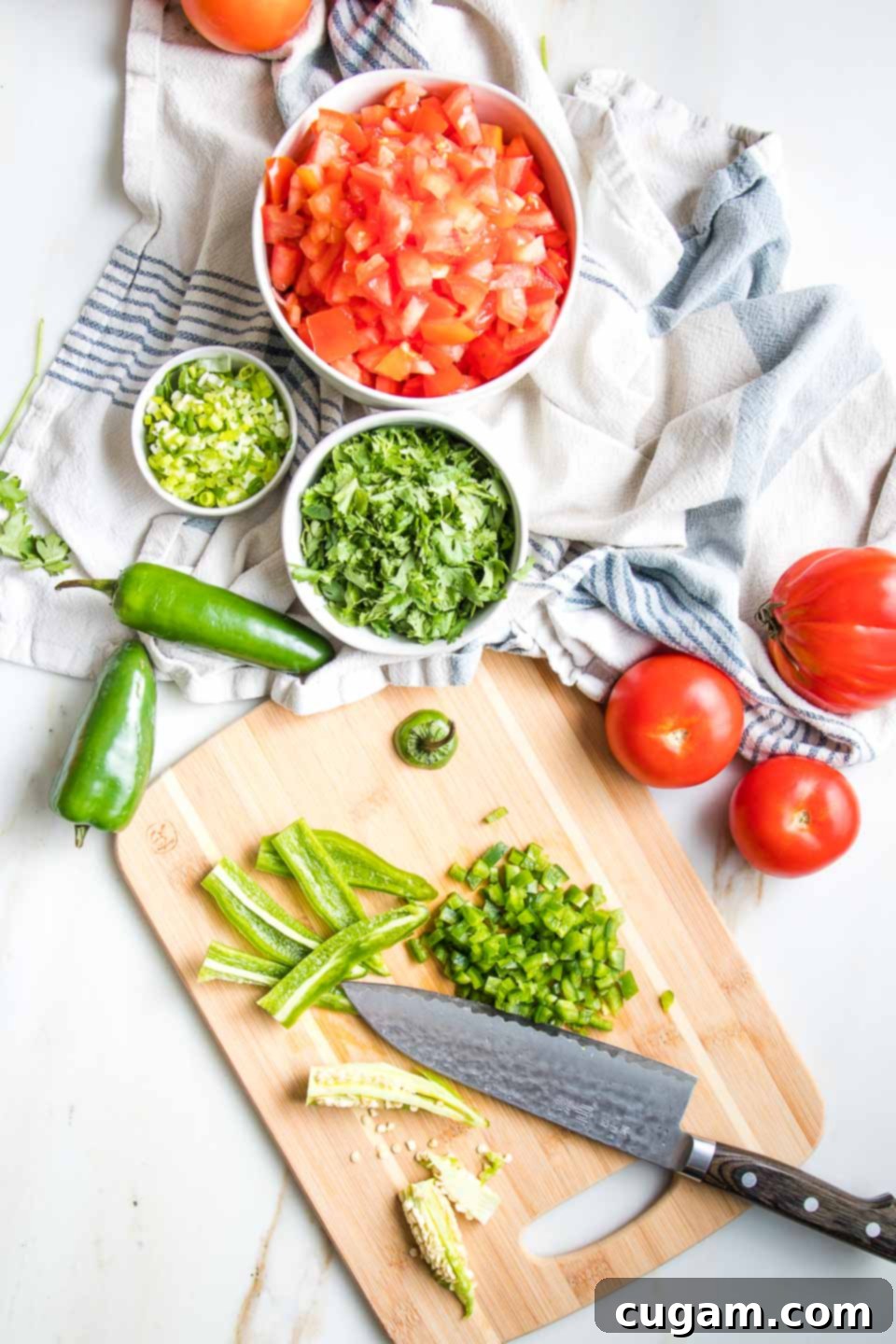
For those who love a truly chunky salsa (pico de gallo style) and enjoy the process of cooking, chopping by hand is the way to go. There’s absolutely no need to peel the tomatoes; the skin adds color, texture, and nutrients. Just grab a sharp serrated knife (it works wonders on tomatoes!) and chop them into small, even dice. Similarly, finely chop the jalapeños and cilantro, and slice the scallions super thin. This method gives you ultimate control over the size and consistency of each ingredient.
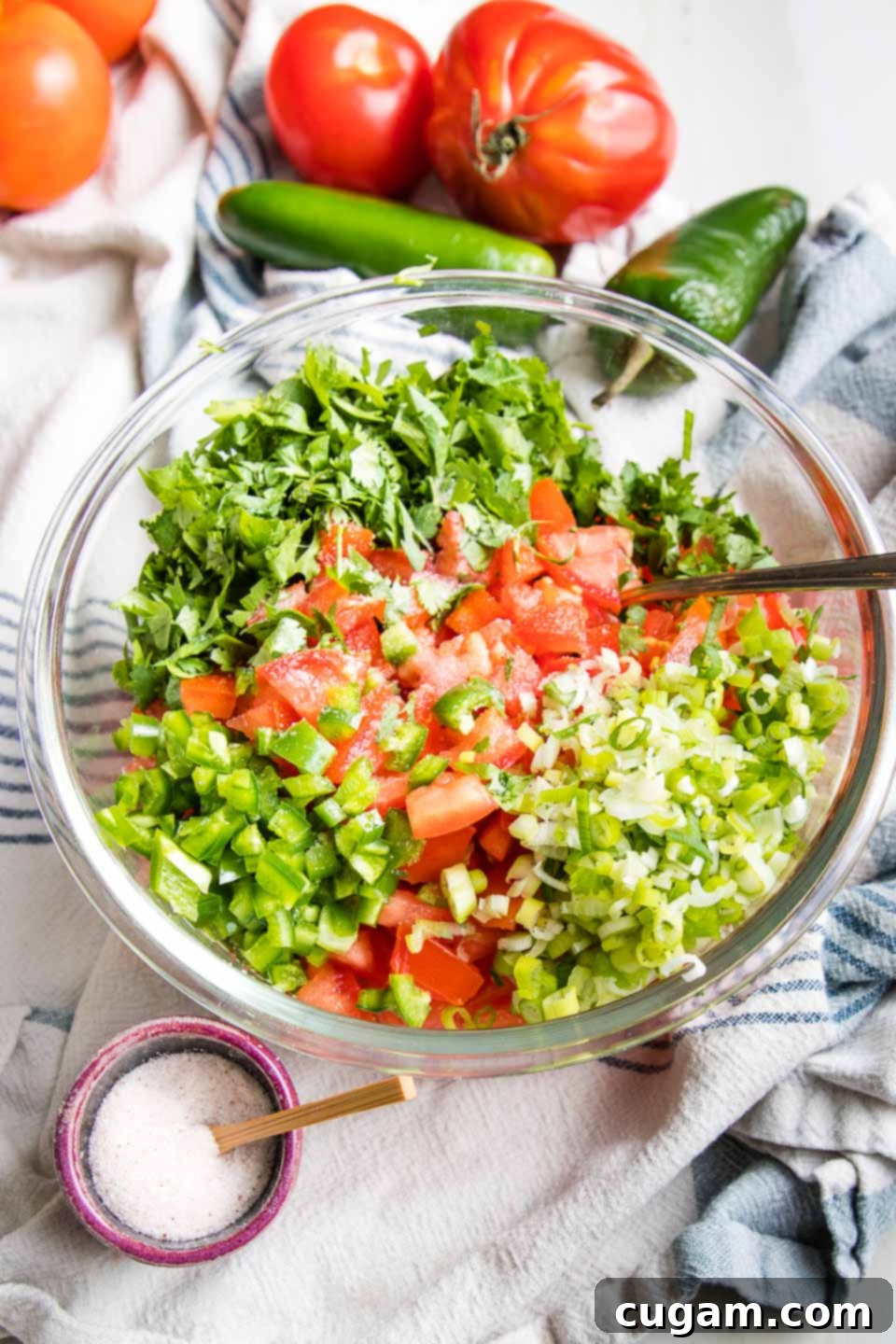
I personally favor this method. Being quick and efficient with a knife, I often find it quicker than the cleanup of a small appliance, and there’s a certain meditative satisfaction in the rhythmic chopping. However, this is truly dependent on your knife skills and personal preference. Know your skill level and choose the method that works best FOR YOU to ensure an enjoyable cooking experience.
Hybrid Method: The Best of Both Worlds
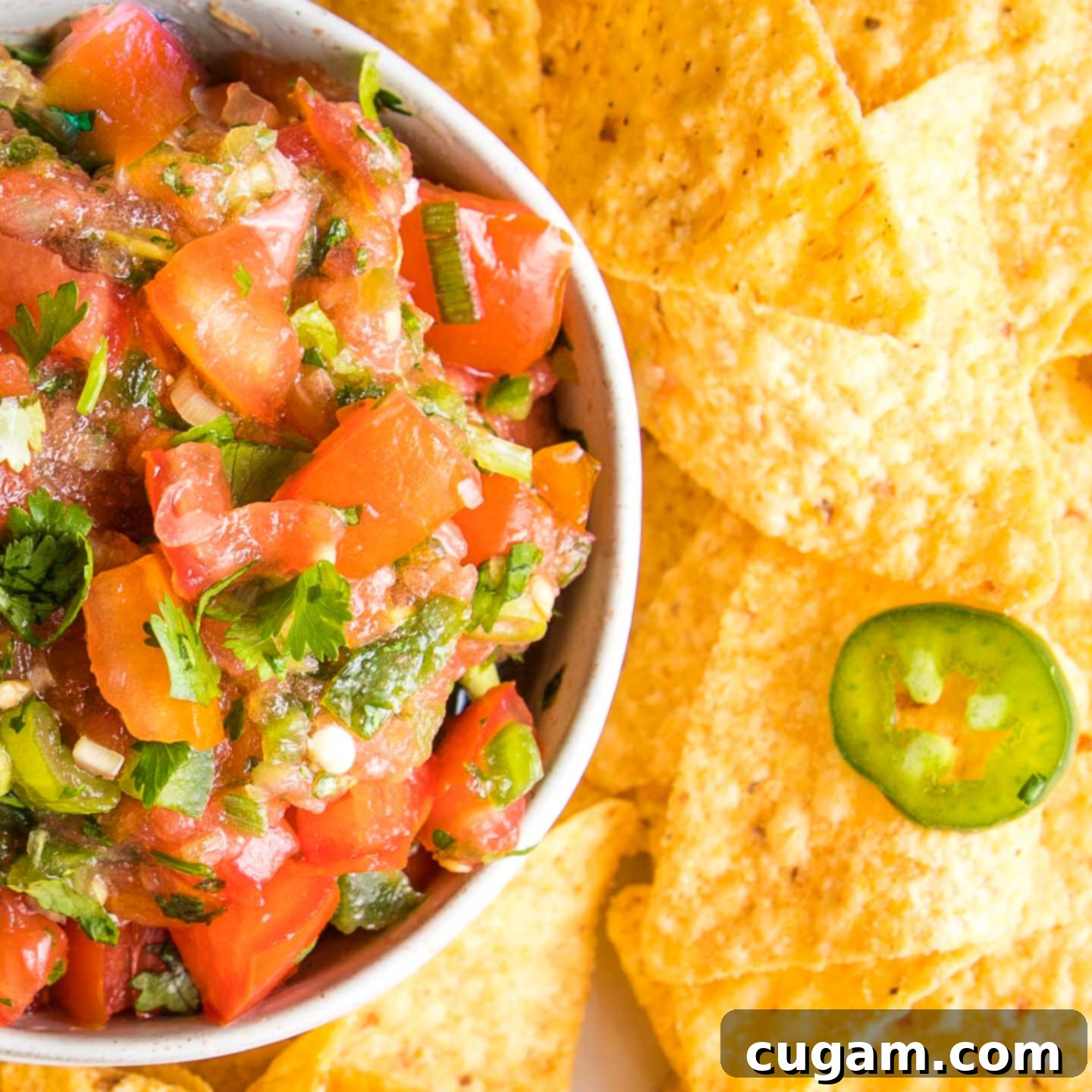
The hybrid method is exactly what it sounds like: a smart combination of machine and hand prep, offering what I consider to be perfection in terms of texture. With this approach, you’ll process some of the vegetables in your food processor or blender for a saucy base, while carefully hand-chopping other components to ensure those delightful, satisfying chunks. For example, you might process most of your tomatoes and a portion of the herbs and peppers, then fold in finely diced fresh tomato, scallions, and jalapeños. This ensures a rich, flavorful background with discernible pieces of fresh produce, giving your salsa fantastic body and visual appeal.
No matter your current skill level in the kitchen, I promise you, you’ve got this! My easy-to-follow directions and helpful tips are designed to guide everyone, even those who might be new to knife work. If you don’t have a bountiful garden of your own, don’t fret! Head to your local farmers’ market for the freshest, most flavorful tomatoes, or simply choose the best available from your grocery store. You could even politely “beg” some off a generous neighbor or friend who has an overflowing harvest! This is a recipe and a season you absolutely do not want to miss. Get ready for homemade Fresh Tomato Salsa for everyone… STAT!
Frequently Asked Questions About Fresh Salsa
Absolutely not! Peeling tomatoes for salsa is an unnecessary step and a total waste of time. The tomato skin adds a little extra texture and a boost of nutrients. A good, sharp serrated knife will cut through the skin beautifully for a hand-chopped salsa, and a food processor or blender will easily break it down without any issue. Embrace the skin for ease and extra goodness!
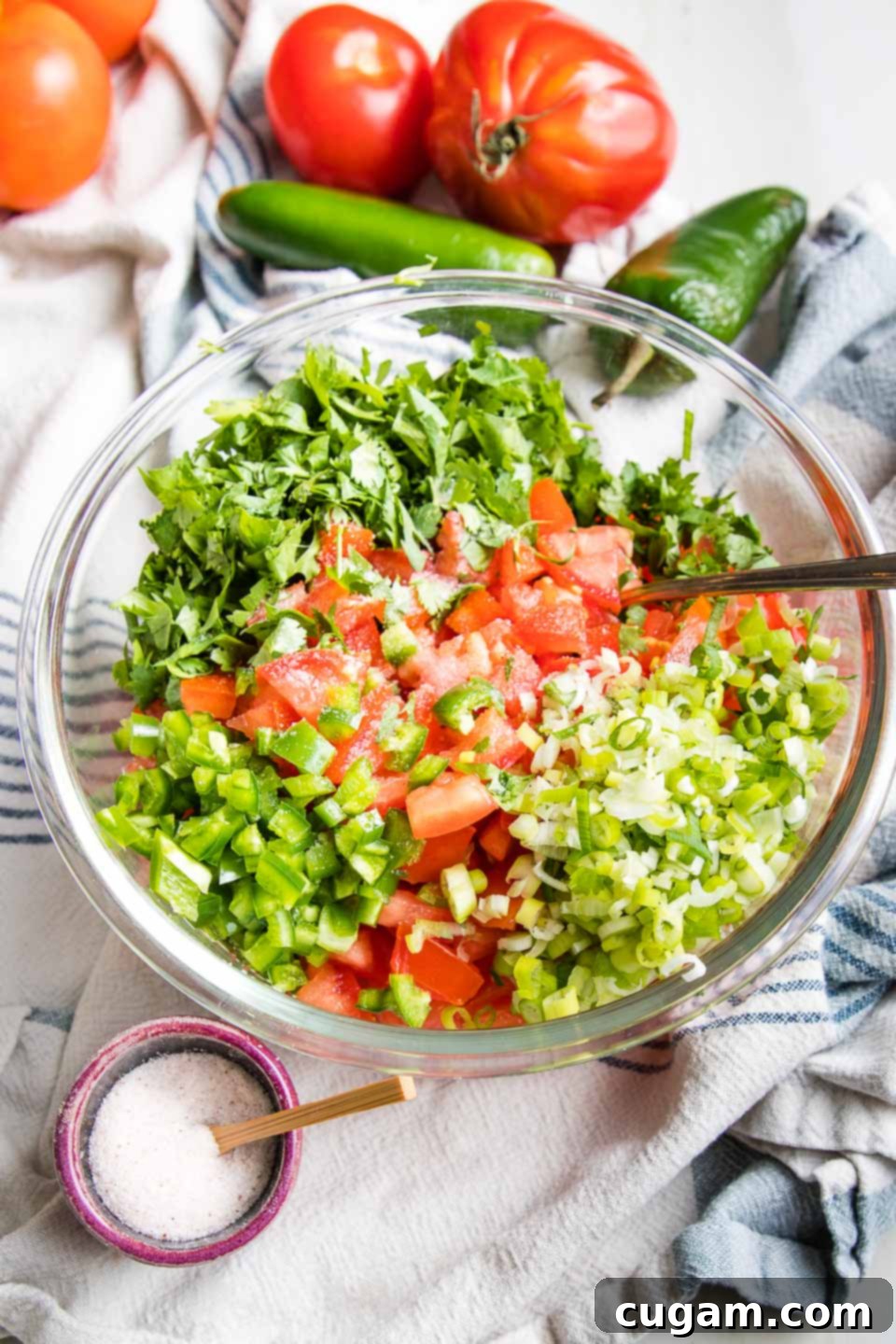
Fresh homemade salsa is best enjoyed as soon as possible, but it will keep well. Store your salsa in an airtight container with a tight-fitting lid in the refrigerator for about 4-6 days. For optimal flavor and texture, I recommend consuming it within the first 2-3 days, as the ingredients will continue to release liquid over time.
When your garden is overflowing, or you just have an abundance of beautiful fresh tomatoes, salsa is just the beginning! You can also make savory baked stuffed tomatoes, a refreshing tomato and basil salad, slice them for your summer flatbread pizza, or create delicious roasted cherry tomatoes that burst with concentrated flavor. The possibilities are endless!
Yes, absolutely! Fresh salsa is an incredibly healthy and nutrient-dense food. Tomatoes and jalapeños are both excellent sources of Vitamin C, which is vital for immune health. Salsa is naturally low in calories and fat, high in water content (aiding hydration), and contains fiber, making it a great choice for promoting satiety and supporting weight management. It’s also packed with antioxidants and other beneficial plant compounds.
More Ways to Celebrate Fresh Tomatoes!
If you love the taste of fresh tomatoes as much as we do, you’ll be thrilled to discover these other fantastic recipes that highlight their versatility and deliciousness. From salads to baked dishes, these ideas will help you make the most of tomato season.
- Easy Summer Pasta Salad
- Vegan Stuffed Tomatoes
- Roasted Cherry Tomatoes with Fresh Herbs
- Tomato and Onion Salad with Balsamic Dressing
Did you know commenting and rating recipes is one of the best ways to support your favorite food bloggers? If you made this delicious Fresh Chunky Tomato Salsa, please consider leaving a five-star rating below and a comment sharing your experience. Also, we’d love to see your creations! Please share your photos on Instagram by tagging me @dkhealthcoach and using the hashtag #debraklein. Your support means the world!
📖 Fresh Chunky Tomato Salsa Recipe
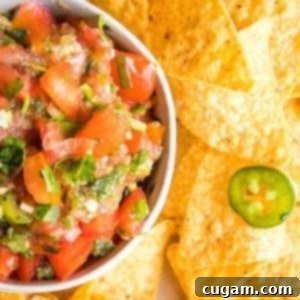
Fresh Chunky Tomato Salsa Recipe
Debra Klein
Rate this Recipe
Pin Recipe
10 minutes
10 minutes
Condiment, Side Dish, Appetizer
American, Mexican, Tex-Mex
12
12 kcal
Ingredients
- 1 ½ lbs fresh tomatoes
- 4 scallions (green onions)
- 2 jalapeño peppers (seeds and membranes removed for milder heat)
- 1 cup fresh cilantro (roughly chopped)
- Optional: Coarse salt, pinch of cumin, garlic powder, or a squeeze of lime juice to taste
Instructions
-
FOOD PROCESSOR OR BLENDER METHOD: Begin by coring your fresh tomatoes, then add them to the food processor or blender. Trim the root end from the scallions, and add both the green and white parts to the processor. For the jalapeños, remove the stem, seeds, and membranes (unless you prefer extra heat), then add them along with the cilantro leaves. Pulse the mixture in short bursts until your desired chunky consistency is reached. Be careful not to over-process, as this can make the salsa too watery.
-
CHOP BY HAND METHOD: Core and finely dice the tomatoes into small, even pieces. Trim the root end from the scallions and thinly slice both the green and white parts. Carefully remove the stem, seeds, and membranes from the jalapeño peppers, then cut them into very small dice. Roughly chop the fresh cilantro leaves. Combine all the chopped ingredients in a bowl. Taste the salsa for seasoning, adding coarse salt and other desired spices (like cumin or a squeeze of lime) to enhance the flavors.
-
THE HYBRID METHOD (My personal favorite for perfect chunky salsa): Set aside one fresh tomato, one scallion, and half of a jalapeño to chop by hand as directed in the “Chop by Hand Method” above. Also, reserve a few sprigs of fresh cilantro. Place the remaining tomatoes, scallions, jalapeños, and cilantro into the bowl of your food processor or blender and pulse until a saucy base forms. Transfer the processed salsa to a large bowl, then fold in the hand-chopped tomatoes, scallions, jalapeños, and cilantro. Mix everything together, taste, and season with salt and other desired spices. This method ensures both rich flavor and satisfying chunks.
Notes
Optional Seasonings: Feel free to experiment with a squeeze of fresh lime juice, ½ teaspoon coarse salt, a pinch of ground cumin, a touch of garlic powder, or even a few crushed red pepper flakes for an extra kick. Adjust to your personal taste.
Storage: Store any leftover fresh salsa in an airtight container in the refrigerator. It will stay fresh for up to a week, but for the best flavor and texture, it’s recommended to consume it within 4 days.
Nutrition
Carbohydrates: 3g
Protein: 1g
Fat: 0.1g
Saturated Fat: 0.02g
Polyunsaturated Fat: 0.1g
Monounsaturated Fat: 0.02g
Sodium: 4mg
Potassium: 158mg
Fiber: 1g
Sugar: 2g
Vitamin A: 627IU
Vitamin C: 12mg
Calcium: 10mg
Iron: 0.2mg
Note
The nutrition calculations were done using online tools. To obtain the most accurate representation of the nutritional information in any given recipe, you should calculate the nutritional information with the actual ingredients you used. You are ultimately responsible for ensuring that any nutritional information is accurate, complete and useful.
Did you make this recipe?
Please leave a review below, then snap a picture and tag me @dkhealthcoach or use hashtag #debraklein on Instagram so I can see it!!
